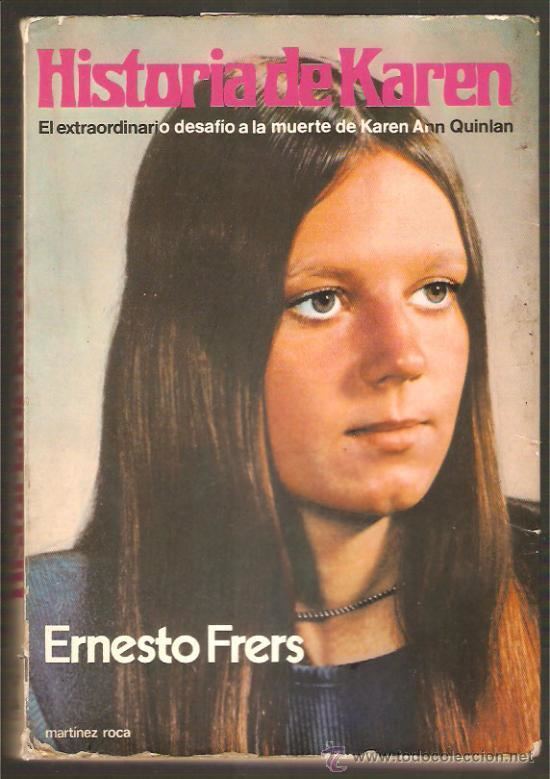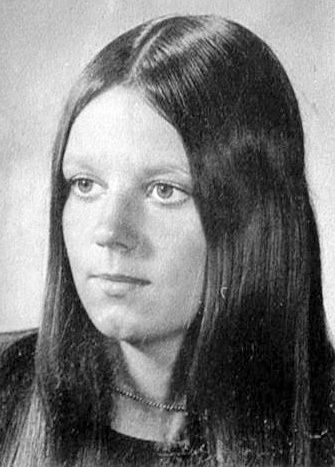Name Karen Quinlan | ||
 | ||
Born March 29, 1954 ( 1954-03-29 ) Scranton, Pennsylvania Died June 11, 1985, Morris Township, New Jersey, United States Similar Terri Schiavo case, Elizabeth Bouvia, Baby M | ||
Karen ann quinlan nhd
Karen Ann Quinlan (March 29, 1954 – June 11, 1985) was an American woman who became an important figure in the history of the right to die controversy in the United States.
Contents
- Karen ann quinlan nhd
- Karen Ann Quinlan Hospice Virtual Tour
- Early life collapse and coma
- Legal battle
- Suit and appeal
- Extraordinary means
- Life after the court decision death and legacy
- Hospice
- Autopsy findings
- In popular culture
- References

When she was 21, Quinlan became unconscious after she consumed diazepam along with alcohol while on a crash diet and lapsed into a coma, followed by a persistent vegetative state. After doctors, under threat from prosecutors, refused the request of her parents, Joseph and Julia Quinlan, to disconnect Quinlan's respirator, which the parents believed constituted extraordinary means of prolonging her life, her parents filed suit to disconnect Quinlan from her ventilator.

Quinlan's case continues to raise important questions in moral theology, bioethics, euthanasia, legal guardianship and civil rights. Her case has affected the practice of medicine and law around the world. A significant outcome of her case was the development of formal ethics committees in hospitals, nursing homes and hospices.

Karen Ann Quinlan Hospice Virtual Tour
Early life, collapse, and coma

Quinlan was born on March 29, 1954, in Scranton, Pennsylvania, to a young, unmarried woman of Irish American ancestry. A few weeks later, she was adopted by Joseph and Julia Quinlan, devout Roman Catholics who lived in the Landing section of Roxbury Township, New Jersey. Julia and Joseph also had a daughter, Mary Ellen, in 1956, and a son, John, in 1957. Quinlan was remembered as an average student at Morris Catholic High School in Denville, New Jersey. After graduation, she worked at the Mykroy Ceramics Corporation in Ledgewood, New Jersey, from 1972 to 1974, and worked several jobs over the next year. Quinlan was a singer and her parents remember her as a tomboy. In April 1975, shortly after she turned 21, Quinlan left her parents' home and moved with two roommates into a house a few miles away in Byram Township, New Jersey. Around the same time, she went on a radical diet, reportedly in order to fit into a dress that she had bought.
On April 15, 1975, a few days after moving into her new house, Quinlan attended a friend's birthday party at a local bar (then known as Falconer's Lackawanna Inn on Lake Lackawanna in Byram Township, New Jersey). She had eaten almost nothing for two days. At the party she reportedly drank a few gin and tonics and took Quaaludes. Shortly afterwards she felt faint and was quickly taken home and put to bed. When friends checked on her about 15 minutes later, they found she was not breathing. An ambulance was called and mouth-to-mouth resuscitation was attempted. Eventually some color returned to her pallid skin, but she did not regain consciousness. Quinlan was admitted to Newton Memorial Hospital in New Jersey in a coma. She remained there for nine days in an unresponsive condition before being transferred to Saint Clare's Hospital, a larger facility. Quinlan weighed 115 pounds (52 kg) when admitted to the hospital.
Quinlan had suffered irreversible brain damage after experiencing an extended period of respiratory failure (lasting no more than 15–20 minutes). No precise cause of her respiratory failure has been given. Her brain was damaged to the extent that she entered a persistent vegetative state. Her eyes were "disconjugate" (they no longer moved in the same direction together). Her EEG showed only abnormal slow-wave activity. Over the next few months she remained in the hospital and her condition gradually deteriorated. She lost weight—eventually weighing less than 80 pounds (36 kg). She was prone to unpredictable, violent thrashing of her limbs. She was given nasogastric feeding and a ventilator to help her breathe.
Legal battle
Quinlan's parents, Joseph Quinlan and Julia Quinlan, requested that she be disconnected from her ventilator, which they believed constituted extraordinary means of prolonging her life because it caused her pain. Hospital officials, faced with threats from the Morris County prosecutor of bringing homicide charges against them if they complied with the parents' request, joined with the Quinlan family in seeking an appropriate protective order from the courts, before allowing the ventilator to be removed.
Suit and appeal
The Quinlans filed a suit on September 12, 1975 to request that the extraordinary means prolonging Karen Ann Quinlan's life be terminated. The Quinlans' lawyers argued that Karen Ann Quinlan's right to make a private decision about her fate superseded the state's right to keep her alive, while Karen Ann Quinlan's court-appointed guardian argued that disconnecting her ventilators would be homicide. The request was denied by New Jersey Superior Court Judge Robert Muir Jr. in November 1975. Judge Muir cited that Quinlan's doctors did not support removing her from the ventilator, that whether or not to do so was a medical rather than a judicial decision, and that doing so would violate New Jersey homicide statutes.
The Quinlans appealed the decision to the New Jersey Supreme Court. On March 31, 1976, the court granted their request, holding that the right to privacy was broad enough to encompass the Quinlans' request on Quinlan's behalf.
When Karen was removed from her respirator/ventilator in May 1976, she surprised many by continuing to breathe unaided. Karen Ann Quinlan's parents never sought to have her feeding tube removed. "We never asked to have her die. We just asked to have her put back in a natural state so she could die in God's time," Julia Quinlan said. She was moved to a nursing home. Karen was fed by artificial nutrition for nine more years, until her death from respiratory failure June 11, 1985.
Extraordinary means
Catholic moral theology does not require that "extraordinary means" be employed in preserving a patient's life. Such means are any procedure which might place an undue burden on the patient, family or others and would not result in reasonable hope of benefiting the patient. A person (or a person's representative in cases when a person is not able to decide) can refuse extraordinary means of treatment even if this will hasten natural death, and this is considered ethical.
It is to this principle that Quinlan's parents appealed when they requested that the extraordinary means of a ventilator be removed, citing a declaration by Pope Pius XII in 1957
Life after the court decision, death, and legacy
After her parents disconnected her ventilator following the successful appeal, Quinlan's parents continued to allow Quinlan to be fed with a feeding tube. Since this did not cause Quinlan pain her parents did not consider it extraordinary means. Quinlan continued to live in a persistent vegetative state until her death from respiratory failure as a result of complications from pneumonia on June 11, 1985, in Morris Plains, New Jersey. Upon learning that Quinlan was expected to die, her parents requested that no extraordinary means be used to revive her. Quinlan weighed 65 pounds at the time of her death. Quinlan was buried at the Gate of Heaven Cemetery in East Hanover, New Jersey.
Hospice
Joseph and Julia Quinlan opened a hospice and memorial foundation in 1980 to honor their daughter's memory. Her court case is linked to legal changes and hospital practices around the right of people to refuse extraordinary means of treatment, even in situations where cessation of treatment could end a life.
Autopsy findings
While Quinlan was alive the extent of damage to her brain stem could not be precisely determined. After she died her entire brain and spinal cord were studied carefully. While her cerebral cortex had moderate scarring, it seemed that her thalamus was extensively damaged bilaterally. Her brain stem (which controls breathing and cardiac functions) was undamaged. These findings suggest that the thalamus plays a particularly important role in consciousness.
In popular culture
The Quinlans published two books about the case: Karen Ann: The Quinlans Tell Their Story (1977) and My Joy, My Sorrow: Karen Ann's Mother Remembers (2005).
A 1977 TV movie, In The Matter of Karen Ann Quinlan, was made about the Quinlan case, with Piper Laurie and Brian Keith playing Quinlan's parents.
The title character of Douglas Coupland's novel Girlfriend in a Coma is Karen Ann McNeil. She collapses after a party where she has taken Valium as well as some alcohol. Like Quinlan, she also has deliberately stopped eating in order to fit into an outfit (in this case, a bikini). For these reasons (and the frequent nostalgic references to events from the 1970s in Coupland's works) the character is thought to be based loosely on Quinlan. In the novel, Karen awakens after being comatose for nearly eighteen years.
